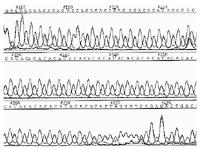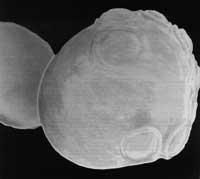Genetic identification of domestic animals
2000/01/01 Estonba, Andone | Jugo, Begoña Iturria: Elhuyar aldizkaria
The mamalian genome (a set of genetic information placed in cells) typical has 3,000 million nucleotide pairs, organized in a linear sequence and with enormous informative content. The genetic variability between individuals of the same species is also enormous. If we knew the whole genome of one individual and read that of another, we would find at least one million different nucleotides!
Of genes (i.e. a product, e.g. a protein, apart from the sequences that form a boiling rule, appear sequences that for us have no meaning. The lack of function of these sequences can sometimes be an advantage, as they may have differences between the individual and the individual, so they can be considered as specific markers of individuals. Among these sequences are several sequences called microsatellites or SHORSTR (Short Tandem Repeat) formed by very short sequences (2, 3 or 4 nucleotides) located in the tandem (one successively). STRs are very polymorphic (variable) so they are very useful in some applications of population biology, as we will see later.
Our team has extensive experience in analyzing and evaluating the genetic variability of populations of domestic animals with markers. In fact, due to the orographic characteristics of Euskal Herria, and the effort made by the baserritarras and cattle ranchers here to maintain the native races, the native races have remained for centuries in our environment. We have 15 native breeds, 6 of them in danger and 7 in critical conservation status. On the other hand, in some of these races, in order to increase their production, Hasle Elkartea is carrying out Improvement Plans with the collaboration of the Councils and the Government. Since all Improvement Plans are based on genealogical and production data, it is essential to avoid genealogical errors that decrease response to selection. Therefore, we propose the development of a genetic system that serves in the Conservation and Improvement Plans of our races, based on polymorphic genetic markers called STR.
The selection of STRs to carry out this work can be easily explained. These short sequences can be amplified by PCR (Polymerase Chained Reaction), obtaining a large number of these sequences from a small amount of DNA. This will greatly facilitate all subsequent analyses. The PCR technique allows to amplify several STR simultaneously. It allows us, therefore, simultaneous access to information from the different regions of the genome (locus). In addition, thanks to the technology developed in recent years, devices have been developed that allow the simultaneous detection of fragments of DNA or alleles marked with different fluorocromes (different sequences of individuals in a given locus). In our case we use a genetic analyzer called ABI-Prism 310, which performs a capillary electrophoresis for the resolution of the different alleles and is able to detect different alleles by laser. This device presents the results in a computerized way. All this guarantees speed, standardization and, above all, the quality of analysis.
With this cutting-edge technology we intend to develop a high-definition system through STR, seeking effective control of the identity of animals. This is above all a decisive advantage for the determination of paternity. As mentioned above, STRs are very variable (5-10 alleles per locus) and the technology used allows a simultaneous study of 11-12 locus. Therefore, we will have a great ability to genetically identify different individuals and a way of stating with great probability that a child has a male as a parent. On the other hand, we will be able to quantify the variability of the populations integrated by these individuals. Finally, if we compare different populations, we will be able to analyze the relationships between them, since this knowledge can be very important to know the evolutionary history of our races.
We intend, as far as possible, to respond to the needs of farmers with our services and that our results serve the development of the primary sector.

Gai honi buruzko eduki gehiago
Elhuyarrek garatutako teknologia






